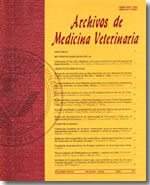Vitrification of bovine oocytes and its use in the parthenogenetic development of embryos
Main Article Content
Abstract
The aim of this study was to evaluate vitrification effects on the viability of chemically activated oocytes in order to produce parthenogenetic bovine embryos. Bovine oocytes retrieved from ovaries obtained in a slaughterhouse were matured in vitro for 20-22 hours and then assigned to the following groups: I (n=76): Vitrified/thawed oocytes, II (n=119): exposed oocytes to cryoprotectans without vitrification and III (n=142): control oocytes. Bovine oocytes were vitrified in microdrops on a precooled aluminum foil floating in liquid nitrogen, using an equilibrium solution with 4% ethylene glycol and a vitrification solution with 35% ethylene glycol, 5% polyvinyl-pyrrolidone and 0,4 M trehalose. The vitrified microdrops were stored in liquid nitrogen and were thawed after 1-3 days of storage. The oocytes of the 3 groups were parthenogenetically activated by 4-min exposure to 5 µM Ca ionomycin at room temperature followed through 5 hours incubation in 6-dimethylaminopurine at 38.5 ºC in a 5% CO2 in humidified atmosphere. Embryos were cultivated on mSOF medium during 8-9 days. The rates of oocytes survival were 55.1% and 93.7% to vitrified/thawed (I) and exposed (II) oocytes respectively. The rates of cleavage were 55.3%, 72.3% and 74.6%; and development to blastocysts were 7.1%, 17.4% and 21.7% in groups I, II and III respectively. These results demonstrate that the oocyte vitrification technique has been set up in our laboratory and parthenogenetic bovine embryos can be produced from such as vitrified/thawed oocytes.

